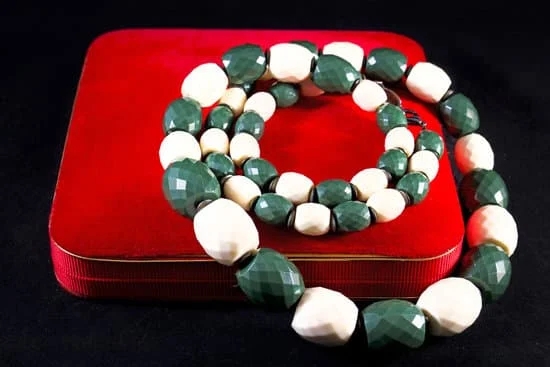Are you interested in learning how to start making handmade jewelry? Whether it’s a hobby or a potential business venture, creating unique and beautiful jewelry can be a rewarding and fulfilling experience. From choosing the right tools and materials to marketing and selling your creations, this guide will take you through the essential steps to kickstart your journey into the world of handmade jewelry making.
Handmade jewelry offers a personal touch that mass-produced pieces simply cannot replicate. Each piece is crafted with care and attention to detail, making it truly one-of-a-kind. In this introduction, we will explore the basics of getting started in the art of handmade jewelry, from finding inspiration for your designs to setting up your workspace for optimal creativity.
Before diving into the technical aspects of jewelry making, it’s important to understand what sets handmade jewelry apart from its machine-made counterparts. Every piece tells a story and reflects the individual style and creativity of its maker. Whether you’re drawn to metalsmithing, beading, or wire wrapping, there are endless possibilities for expressing your unique vision through handmade jewelry. Join us as we embark on this creative journey together.
Choosing the Right Tools and Materials
When it comes to making handmade jewelry, choosing the right tools and materials is crucial for creating beautiful and high-quality pieces. As a beginner, navigating the world of jewelry-making supplies can be overwhelming, but with the right guidance, you can build a collection of essential tools and materials to kickstart your creative journey.
To begin making handmade jewelry, here are some essential tools and materials that you will need:
- Pliers: A set of basic pliers including round-nose, chain-nose, and flat-nose pliers will be necessary for bending, shaping, and manipulating wire and jump rings.
- Wire cutters: These are essential for cutting wire and metal components to the desired lengths.
- Beading mat: A soft surface to prevent beads from rolling away as you work on your designs.
- Beads and gemstones: These are the focal point of your jewelry pieces. Choose a variety of colors, shapes, sizes, and textures to add visual interest to your creations.
- Jewelry findings: This includes items such as clasps, jump rings, ear wires, headpins, and crimps that are used to finish off your jewelry pieces.
In addition to these basic tools and materials, it’s important to do research on what specific supplies are needed for the type of jewelry you want to create. For example if you want to start making wire-wrapped pendants or earrings you will need specific types of wire (copper wire or sterling silver wire), if you’re interested in beadwork then bead embroidery thread or bead-weaving needles would be necessary.
By carefully choosing the right tools and materials that align with your desired style of jewelry-making will set a strong foundation for your handmade jewelry business.
Getting Inspired
Exploring Different Styles
When starting to make handmade jewelry, it’s important to explore different styles and techniques to find what resonates with you. Take the time to browse through jewelry-making books, attend craft fairs, and explore online platforms such as Pinterest and Instagram for inspiration. By exposing yourself to a variety of designs, you can begin to identify the elements that appeal to you and start developing your own unique style.
Finding Your Niche
One way to stand out in the handmade jewelry market is by finding your niche. Consider what makes your designs different from others and think about your target audience. Are you drawn to minimalist, modern pieces or intricate, bohemian designs? Maybe you have a passion for creating eco-friendly jewelry using sustainable materials. Whatever it may be, finding a niche can help you establish a strong identity for your brand and attract a specific customer base.
Seeking Inspiration From Nature and Everyday Life
Sometimes inspiration can come from unexpected sources. Pay attention to nature, architecture, textures, and colors in everyday life – these could spark new ideas for your jewelry designs. Taking walks in nature or exploring new environments can help open up new creative avenues for crafting unique handmade jewelry pieces.
By discovering what inspires you most, you’ll be better equipped to identify your personal style and niche in the world of handmade jewelry making.
Learning the Basics
When starting to make handmade jewelry, it’s important to have a good understanding of the basic techniques involved. Here are some key jewelry making techniques that every beginner should learn:
- Wire Wrapping: This technique involves using wire to secure beads and other components together. It’s a versatile technique that can be used to create earrings, pendants, and more.
- Beading: Beading is the process of creating jewelry using various types of beads, such as seed beads, glass beads, or gemstone beads. It involves stringing beads onto thread or wire to create beautiful designs.
- Metal Stamping: Metal stamping involves using metal stamps to imprint letters, numbers, or designs onto metal jewelry components. This technique is commonly used to create personalized pendants and charms.
Learning these basic techniques will provide you with a solid foundation for making handmade jewelry. There are many online tutorials and workshops available that can help you master these skills. You can also consider joining a local jewelry making class or workshop where you can learn from experienced artisans.
In addition to these basic techniques, it’s important to familiarize yourself with essential jewelry making tools such as pliers, wire cutters, bead mats, and jewelry adhesives. Having the right tools on hand will make the jewelry-making process much easier and more enjoyable.
It’s also important to practice patience and persistence when learning new techniques. Don’t be discouraged if your first few attempts don’t turn out as expected – like any skill, jewelry making takes time and practice to master. With dedication and perseverance, you’ll soon find yourself creating beautiful handmade pieces that you can be proud of.
Setting Up Your Workspace
Designating a Dedicated Space
When starting to make handmade jewelry, it’s essential to have a designated area for your work. Whether it’s a spare room, a corner of your living room, or even just a small table, having a dedicated workspace will help you stay organized and focused. Make sure this area is well-lit and free from distractions that could hinder your creativity and productivity.
Organizing Tools and Materials
As you start accumulating tools and materials for making handmade jewelry, it’s crucial to keep everything organized. Invest in storage containers, shelves, and organizers to keep beads, wire, pliers, and other supplies neatly arranged. This not only makes it easier to find what you need but also helps prevent accidents like stepping on loose beads or misplacing important tools.
Creating an Inspiring Atmosphere
Your workspace should be an environment that sparks creativity and inspiration. Consider adding personal touches like artwork, plants, or motivational quotes to make the space feel inviting. Additionally, playing soothing music or having scented candles can contribute to a relaxed and enjoyable atmosphere as you work on creating beautiful handmade jewelry pieces.
Now that you’ve set up your workspace, you’re ready to fully immerse yourself in the art of making handmade jewelry. With the right environment in place, you can focus on honing your skills and creating stunning pieces that reflect your unique style and passion for jewelry making.
Marketing and Selling Your Handmade Jewelry
Once you’ve created your stunning handmade jewelry pieces, the next step is to showcase and sell them. Marketing and selling your creations can be a daunting task, but with the right approach and strategies, you can successfully promote and distribute your work to a wider audience.
One of the most effective ways to market your handmade jewelry is by leveraging the power of social media. Platforms like Instagram, Facebook, Pinterest, and Twitter are excellent tools for reaching potential customers and showcasing your designs. You can create visually appealing posts, run targeted ads, engage with followers, and even collaborate with influencers in the jewelry or fashion industry to promote your brand.
In addition to social media, having an online presence through a website or an e-commerce platform is essential for selling your handmade jewelry. This allows you to reach a global audience and gives customers easy access to browse and purchase your products. Building a user-friendly website that showcases your collection, provides detailed product descriptions, and offers secure payment options is crucial for attracting and retaining customers.
Furthermore, participating in local craft fairs, pop-up markets, and artisanal events can also be a great way to connect with potential customers face-to-face. These events provide an opportunity to personally interact with buyers, receive direct feedback on your designs, and build a loyal customer base. Additionally, consider reaching out to local boutiques or consignment shops that align with your brand aesthetic to inquire about potential partnerships or wholesale opportunities.
| Marketing Strategies | Selling Techniques |
|---|---|
| Social Media Marketing | Creating an E-commerce Website |
| Participating in Craft Fairs | Collaborating with Local Boutiques |
The Importance of Quality Control and Customer Satisfaction
Once you have started making handmade jewelry, it is important to place a great deal of focus on the quality of your products and the satisfaction of your customers. Quality control is crucial in ensuring that the jewelry you produce meets the standards and expectations of your customers.
By paying attention to detail and using high-quality materials, you can create jewelry that not only looks beautiful but also lasts a long time. Remember that the reputation of your brand depends on the quality of your products, so be sure to prioritize this aspect in your jewelry making process.
In addition to quality control, customer satisfaction plays a significant role in the success of your handmade jewelry business. Take the time to listen to feedback from your customers and use it as an opportunity to improve your designs and services. Building a good relationship with your customers will lead to repeat business and positive word-of-mouth referrals. Offer excellent customer service, and ensure that their shopping experience is enjoyable by being responsive, transparent, and accommodating.
To start making handmade jewelry with an emphasis on quality control and customer satisfaction, consider creating a thorough quality control checklist for each piece you make. Inspect each finished product for any imperfections before offering them for sale.
In terms of customer satisfaction, prioritize open communication with customers through avenues such as social media or email. Implementing these practices from the beginning will set a strong foundation for building a successful handmade jewelry business focused on delivering high-quality pieces while establishing trust with your customer base.
Troubleshooting Common Beginner Mistakes
When starting to make handmade jewelry, it is common to encounter some mistakes along the way. However, knowing how to troubleshoot these beginner mistakes is essential in improving your craft and creating high-quality handmade jewelry. One of the most common beginner mistakes is using the wrong tools or materials for a specific technique. It’s important to research and understand the proper tools and materials needed for each jewelry making technique before starting any project.
Another common mistake that beginners make when making handmade jewelry is improper use of techniques such as wire wrapping, bead stringing, or metal stamping. This can result in poorly constructed jewelry pieces that may easily break or tarnish over time. Taking the time to learn and practice these techniques properly will greatly improve the quality of your handmade jewelry.
Lastly, many beginners struggle with pricing their handmade jewelry. Setting prices that are too low can undercut your worth as an artist, while setting prices too high may deter potential customers. Researching the market value of similar handmade jewelry pieces and considering both the cost of materials and the time spent creating each piece can help you determine a fair price for your creations.
It’s important for beginners in handmade jewelry making to understand that mistakes are part of the learning process. By troubleshooting common beginner mistakes, you can improve your skills and create beautiful, high-quality handmade jewelry that you can be proud of.
| Common Beginner Mistakes | Troubleshooting Tips |
|---|---|
| Using wrong tools/materials | Research proper tools/materials for each technique |
| Improper use of techniques | Take time to learn and practice techniques thoroughly |
| Pricing struggles | Research market value and consider costs when setting prices |
Conclusion
In conclusion, starting to make handmade jewelry can be a fulfilling and rewarding journey for anyone with a passion for creativity and design. By following the beginner’s guide to choosing the right tools and materials, understanding jewelry making techniques, and creating the perfect workspace environment, you can set yourself up for success in this craft.
Finding inspiration for your unique style and niche, along with focusing on quality control and customer satisfaction, are also crucial steps in becoming a successful handmade jewelry maker.
As you embark on this journey, it’s important to remember that marketing and selling your handmade jewelry is just as important as the creation process itself. Utilizing online platforms, craft fairs, or local markets can help you reach potential customers and build a loyal following for your brand. Additionally, learning how to troubleshoot common beginner mistakes will help you continue to improve your craft and grow as a maker.
The possibilities in the world of handmade jewelry making are endless, and by staying dedicated to honing your skills, finding your unique voice in the industry, and consistently providing top-notch products and service, you can truly find success in this creative endeavor. So if you’re considering how to start making handmade jewelry, don’t hesitate to dive into this exciting world of artistry and entrepreneurship.
Frequently Asked Questions
How Do I Get Started in Jewelry Making?
Getting started in jewelry making requires some basic tools and materials such as pliers, wire cutters, beads, and clasps. It’s important to learn some fundamental techniques through classes or online tutorials before diving in.
What Do You Need to Make Handmade Jewelry?
To make handmade jewelry, you’ll need basic tools like pliers, wire cutters, and scissors. In addition, you’ll need materials such as beads, wire, clasps, and charms. It’s also helpful to have a workspace with good lighting and organization for your supplies.
Is It Profitable to Sell Handmade Jewelry?
Selling handmade jewelry can be profitable if you find the right niche and have a good marketing strategy. Building a strong brand, creating high-quality pieces, and finding the right distribution channels are all important factors in making a profit from selling handmade jewelry.

Welcome to my jewelry blog! My name is Sarah and I am the owner of this blog.
I love making jewelry and sharing my creations with others.
So whether you’re someone who loves wearing jewelry yourself or simply enjoys learning about it, be sure to check out my blog for insightful posts on everything related to this exciting topic!





